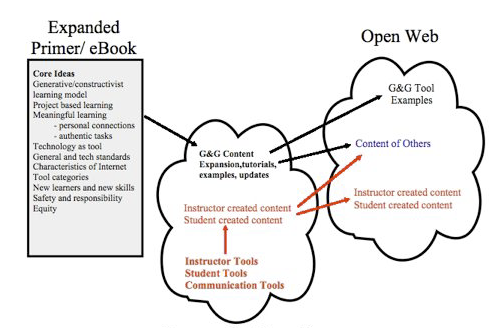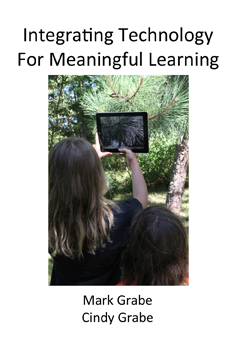This is the third in my series of posts describing what I propose as a new model for textbook publishing. The model was developed specifically to address the needs of courses intending to prepare teachers to make better use of technology in their classrooms, but some of the ideas may have broader value.

Four or so years ago we approached our publisher with a formal proposal for what we described as the $29 textbook project. I still have the proposal and the image that appears above was included in the proposal to identify some important components of the proposal. The core idea was to retain a traditional book (paper or online) in a significantly smaller and less expensive size and to offer more content online. This may sound unremarkable, but companies fail to follow through on such a model. The book is simply never downsized. Costs are never cut in a significant way.
The image identifies the three components – the Primer (book), closed web, and open web – we proposed to develop. At the time, the $29 model assumed students would pay for the Primer and the closed web content. The closed web implied the generation of resources that would be available online. The phrase “closed web” implied only that it would be necessary to operate a server to offer these resources. The open web implied the creation of examples available as “public” or “shared” content using services such as Flickr, YouTube, or Diigo. Instead of describing how such services could be useful, the intent was to demonstrate fully functional examples using the services of interest.
The one idea of general value from our plan may be that different delivery systems have unique advantages and disadvantages. While others may disagree with the issues I identify, I would argue that differentiating ways in which learning resources can be provided and considering which resources are best suited to which method of delivery would be a way for publishers to move beyond the traditional book.
Some ideas (from what I remember):
The book: The book should identify the content structure and the core concepts promoted by the author. These components are the message the author intends to promote. Your message should have some longevity over time so be willing to commit to core ideas for several years.
The closed web (The stuff available from the sponsored server. The phrase “closed web” probably made more sense when I was proposing that this be provided by the book company and available only to those who purchased the Primer.): The core message needs to be extended in multiple ways. First, what do key ideas look like in the present. If you have not written a large traditional book, you may not understand that the lag between some of the first things you write and when the finished product is available to a reader may be well over a year. We are discovering that the world moves too fast in many disciplines to offer a useful description in a product that takes a significant amount of time to develop and then is expected to remain static for an additional period of time. What research on important topics has become available in the past year? What tools might presently be available to implement classroom to classroom interaction? What are the present sources of inquity that frustrate the full potential applications of technology to learning? What legislation must be considered as students engage with technology?
Second, what experiences are best presented through multimedia. For example, tutorials for how to use specific tools make more sense as demonstrations than as text-based descriptions.
Finally, the closed web can offer resources to allow the instructor to customize the experience available to the students taking a particular course. Is the course a sophomore course provided to future teachers or a graduate course provided online to experienced teachers interested in new ideas for their classrooms? Is the course focused on teachers preparing to work in elementary or secondary classrooms? Does the instructor value a research perspective for the proposed activities or does the instructor believe the course should take a narrower focus? It is feels great to be able to develop a resource you realize will be highly valued by some but be irrelevant to others.
The open web: We will likely rely more and more on software as a service applications. Why not prepare and allow access to fully developed projects for students to explore? What does a Flickr site with several thousand photos look like? What does a social bookmarking site build to cover the topics explored in the Primer look like? What would a blog developed over 10 year years as a way to explore educational issues look like? Examples of projects offer a way to explore that support and extend general descriptions.
You might have noticed one other thing in the diagram. Some of the text and arrows appear in red. Once an author makes a real commitment to online resources, the online environment offers a very real opportunity to engage learners of all types in an interactive way. We can offer you a book, tutorials and summaries of relevant current issues. You can likely offer me and others creative ways to teach the content of a course that might use this book. Your students might generate interesting projects as a consequence of such courses. I have been enamored of the idea of the participatory web for years and believe that the potential is there for good ideas to flow from many different individuals. I see our responsibility as creating a structure within which this is possible.
Some might suggest that new ebooks allow the incorporation of multimedia and can be updated by the author as necessary. I know that. However, the multimedia infused book still has the problem of trying to be everything to everyone. As an alternative, I have been playing with the idea of an instructor “loaded” interactive syllabus. This is the idea that an instructor could select a set of resources from a collection within a self-defined structure embellished with instructor created resources. Maybe I can explore this idea in a future post.
![]()


You must be logged in to post a comment.